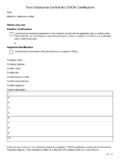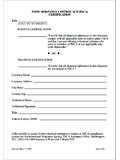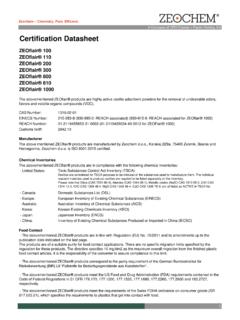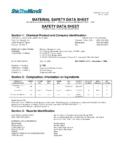Transcription of MISSISSIPPI LIME COMPANY – MATERIAL SAFETY DATA …
1 MISSISSIPPI LIME COMPANY MATERIAL SAFETY data sheet . OSHA HAZARD COMMUNICATION. PRODUCT IDENTIFICATION CHEMICAL ABSTRACT DATE REVISED. Calcium Oxide CAS 1305-78-8 1/1/2012. Quicklime Previous Versions Obsolete Product Line: MicroCal OF100, OF200, OF325, OFT15; PolyCal . OFT15, OF325, 0S325; PetroCal - OF100, OS100; Standard Quicklime Granular, , 1 , 2 , 2X1, Pulverized, Flow Treated, CG; VitaCal O. Section I. MANUFACTURER 24 Hour Emergency Contact HMIS RATING. Number: (800) 437-5463. MISSISSIPPI Lime COMPANY Health - 3. 16147 US Highway 61 Telephone Number for Flammability - 0. Ste Genevieve, MO 63670 Information: (800) 437-5463 Physical Hazards - 1. Protective Equip - E. Signature of Preparer Castleberry Section II Hazardous Ingredients / Identity Information Specific Chemical Identity; OSHA PEL ACGIH TLV Other Limits %.
2 Common Names Recommended (Optional). Calcium Oxide; Lime; Quicklime 5 mg/m3 2 mg/m3. Crystalline Silica (Quartz) mg/m3 mg/m3 Respirable to %. Calcium oxide is not listed on the NTP, IARC, or OSHA lists of carcinogens. Crystalline silica, a component of this product, is listed by IARC and NTP but not by OSHA. In 1997, IARC determined that crystalline silica inhaled in the form or quartz or crystobalite from occupational sources is carcinogenic to humans (Group 1). OSHA requires that products containing > of a known carcinogen must be labeled. NTP. states that silica, crystalline (respirable) may reasonably be anticipated to be a carcinogen (1991). MISSISSIPPI Lime COMPANY recommends using personal protection equipment when handling this product. Section III Physical / Chemical Characteristics o Boiling Point (Calcium Oxide) 5162 F Specific Gravity (H2O) = 1) 2 o Vapor Pressure (mm Hg) NA Melting Point Loses CO 4662 F.
3 Vapor Density (Air = 1) NA Evaporation Rate NA. Solubility in Water Reacts with water to form calcium hydroxide Appearance and Color Odorless; White / light gray pebble, granules, or powder Section IV Fire and Explosion Hazard data Flash Point NA Flammable Limits NA. Extinguishing Method NA. Special Fire Fighting Procedures Caution! Water application may produce exothermic reaction and release sufficient heat to ignite combustible MATERIAL . Unusual Hazards - Storage Wet or unused product stored for lengthy periods will absorb moisture potentially rupture bags resulting in spillage. Page 1 of 3. PRODUCT IDENTIFICATION CHEMICAL ABSTRACT DATE REVISED. Calcium Oxide CAS No. 1305-78-8 1/1/2012. Quicklime . Section V Reactivity data Stability Stable X Conditions to Avoid NA. Incompatibility (Materials to Avoid) Water, Acids, Inter-halogens, Phosphorus (V) Oxide Hazardous Decomposition or Byproducts None Hazardous May Occur Conditions to Avoid NA.
4 Polymerization Will Not Occur X. Section VI Health Hazard data Inhalation? Absorption Through Skin? Ingestion (swallowing)? . Route(s) of Entry YES YES YES. Acute Prolonged contact may irritate or burn skin - especially in the presence of moisture. Inhalation of dust may irritate mucous membranes or respiratory passages. Direct eye contact may cause permanent damage. Health Hazards Chronic Long term exposure can cause irritation, ulceration and perforation of nasal septum. Carcinogenicity NTP? IARC Monographs? OSHA Regulated? Calcium Carbonate NO NO NO. Crystalline Silica YES YES YES. Signs and Symptoms of Exposure Irritation of eyes, respiratory tract, red sun burned skin Medical Conditions Generally Respiratory disease, dry skin condition. Aggravated by Exposure Emergency and First Aid Procedures Provide fresh air.
5 Scrub off dust with soap and water. Drink plenty of water if swallowed. Flush eyes immediately with water immediately and contact physician. Section VII Precautions for Safe Handling Steps to Be Taken in Case MATERIAL is Normal clean-up procedures. Care should be taken to avoid Released or Spilled causing dust to become airborne. Vacuum cleaning systems are recommended. Waste Disposal Method Dispose of product in accordance with Federal, State and Local regulations. See Section IX. Precautions to Be Taken in Handling Store away from water and acids. Other Precautions Product should never be discarded with wet combustible MATERIAL or commingled in containers exposed to rainfall. Section VIII Control Measures Respiratory Protection - Dust filter masks are recommended for personal comfort and/or protection Ventilation Local Exhaust To maintain TLV's and PEL's Special None Mechanical To maintain TLV's and PEL's Other None Protective Gloves Cloth or leather gloves.
6 Reduce wrist burns from sweat by using protective cream. Eye Protection ALWAYS wear shielded glasses and/or fitted goggles around product to reduce eye injury. Flush eyes immediately and seek medical attention. Contact lenses may impede first aid. Other Protective Clothing Wear long sleeve shirts and pants to minimize contact with product. Work / Hygienic Practices Maintain dust exposure limits below TLV's and PEL's. Whenever necessary wear respiratory protection. Air blowers are effective for dedusting clothing. Page 2 of 3. PRODUCT IDENTIFICATION CHEMICAL ABSTRACT DATE REVISED. Calcium Oxide CAS No. 1305-78-8 1/1/2012. Quicklime . Section IX Regulatory Compliance Guidance CONEG Materials used to manufacture bags containing products are CONEG compliant. CWA Product contains alkaline MATERIAL potentially toxic to aquatic life if concentration is elevated for extended periods of time.
7 Minimize contact with storm water runoff. DOT Product is not regulated by Dept of Transportation - unless shipped by air. EPA Waste derived from unused products is not subject to RCRA. Waste is acceptable at most landfills as a special waste but can often be beneficially reused for other purposes. Commingling waste product with wet combustible refuse may result in fire in trash containers and trucks. SPILL Whenever possible, contain and sweep up spillage in dry form rather than flushing with water. Fire may occur in containers if damp product is placed in direct contact with combustible materials. TSCA Product is listed on Toxic Substance Control Act, Canada DSL and all other International Inventories Prop65 Subject to California Proposition 65 warning labeling requirements due to presence of trace metals and crystalline silica above instrument detection levels.
8 NAFTA Product qualifies under HS Tariff No as 100% US Origin, Preference Criteria A. Annual certification will be provided upon request. REACH Product has been pre-registered under # 05-2116 374 516-39-0000 EINECS 215-138-9. Page 3 of 3.






